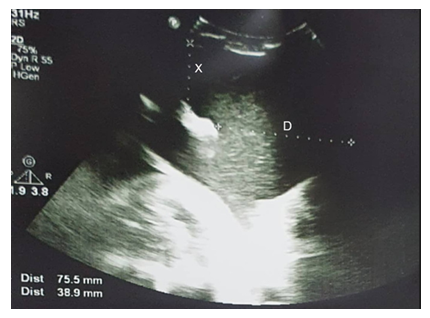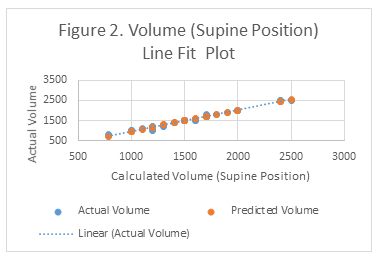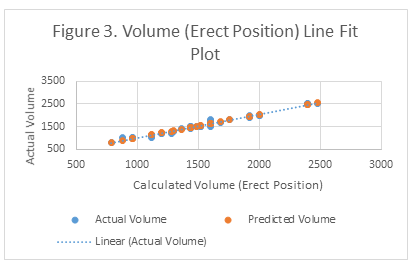Evaluation of The Diagnostic Potential of Sonography in Pleural Effusion in Supine and Erect Positions
Article Information
Sara Salarian.M.D.1, Masoomeh Raoufi M.D.2, Navid Shafigh M.D.1, Seyed Mehdi Shahnematollahi M.D.3, Nazanin Sadraei M.D.4*,Mahnaz Ghanbari DDS5
1Anesthesiology and Critical Care Department, Shahid Beheshti University of Medical Sciences, Tehran, Iran.
2Assistant Professor of Radiology,Department of Radiology, Shahid Beheshti University of Medical Sciences, Tehran, Iran.
3School of medicine, Shiraz University of Medical Science, Shiraz, Iran
4Medical Imaging Research Center, Shiraz University of Medical Sciences, Shiraz, Iran
5Departmentof Pediatric Dentistry, Faculty of Dentistry, Shahed University,Tehran, Iran
*Corresponding Author: Nazanin Sadraei M.D., Medical Imaging Research Center, Shiraz University of Medical Sciences, Shiraz, Iran.
Received: 10 February 2023; Accepted: 20 February 2023; Published:18 March 2023
Citation: Sara Salarian.M.D., Masoomeh Raoufi M.D., Navid Shafigh M.D., Nazanin Sadraei M.D., Mahnaz Ghanbari DDS. Evaluation of The Diagnostic Potential of Sonography In Pleural Effusion In Supine And Erect Positions. Journal of Radiology and Clinical Imaging. 6 (2023): 58-61.
Share at FacebookAbstract
Rationale and Objectives: Chest tube insertion in patients with pleural effusion necessitates a pre-procedural evaluation of the fluid amount. Ultrasound is currently the most efficient modality for this evaluation. In this study, we aimed to seek a simple diagnostic method to evaluate the volume of pleural effusion.
Materials (patients) and Methods: This study includes 38 ICU patients who were diagnosed with pleural effusion in their chest x-ray. We measured the maximum distance from the diaphragm to the pleura in the erect position and the maximum distance from the visceral pleura to the chest wall in the supine position to estimate the amount of pleural effusion. Then we used a simple regression model to compare the estimated values with the actual amount of fluid.
Result: There is a linear relationship between the estimated values of pleural effusion in the erect and supine positions and the actual amount of fluid.
Conclusion: Maximum distance between the diaphragm and pleura in the erect position and the maximum distance between visceral pleura and chest wall could be utilized to estimate the pleural effusion volume with high accuracy in ICU patients. This could be a cost-effective simple method for the management of pleural effusion in ICU patients.
Keywords
pleural effusion; erect position; supine position; sonography; thoracosynthesis.
pleural effusion articles; erect position articles; supine position articles; sonography articles; thoracosynthesis articles
pleural effusion articles pleural effusion Research articles pleural effusion review articles pleural effusion PubMed articles pleural effusion PubMed Central articles pleural effusion 2023 articles pleural effusion 2024 articles pleural effusion Scopus articles pleural effusion impact factor journals pleural effusion Scopus journals pleural effusion PubMed journals pleural effusion medical journals pleural effusion free journals pleural effusion best journals pleural effusion top journals pleural effusion free medical journals pleural effusion famous journals pleural effusion Google Scholar indexed journals erect position articles erect position Research articles erect position review articles erect position PubMed articles erect position PubMed Central articles erect position 2023 articles erect position 2024 articles erect position Scopus articles erect position impact factor journals erect position Scopus journals erect position PubMed journals erect position medical journals erect position free journals erect position best journals erect position top journals erect position free medical journals erect position famous journals erect position Google Scholar indexed journals supine position articles supine position Research articles supine position review articles supine position PubMed articles supine position PubMed Central articles supine position 2023 articles supine position 2024 articles supine position Scopus articles supine position impact factor journals supine position Scopus journals supine position PubMed journals supine position medical journals supine position free journals supine position best journals supine position top journals supine position free medical journals supine position famous journals supine position Google Scholar indexed journals sonography articles sonography Research articles sonography review articles sonography PubMed articles sonography PubMed Central articles sonography 2023 articles sonography 2024 articles sonography Scopus articles sonography impact factor journals sonography Scopus journals sonography PubMed journals sonography medical journals sonography free journals sonography best journals sonography top journals sonography free medical journals sonography famous journals sonography Google Scholar indexed journals thoracosynthesis articles thoracosynthesis Research articles thoracosynthesis review articles thoracosynthesis PubMed articles thoracosynthesis PubMed Central articles thoracosynthesis 2023 articles thoracosynthesis 2024 articles thoracosynthesis Scopus articles thoracosynthesis impact factor journals thoracosynthesis Scopus journals thoracosynthesis PubMed journals thoracosynthesis medical journals thoracosynthesis free journals thoracosynthesis best journals thoracosynthesis top journals thoracosynthesis free medical journals thoracosynthesis famous journals thoracosynthesis Google Scholar indexed journals ICU articles ICU Research articles ICU review articles ICU PubMed articles ICU PubMed Central articles ICU 2023 articles ICU 2024 articles ICU Scopus articles ICU impact factor journals ICU Scopus journals ICU PubMed journals ICU medical journals ICU free journals ICU best journals ICU top journals ICU free medical journals ICU famous journals ICU Google Scholar indexed journals Chest X-ray articles Chest X-ray Research articles Chest X-ray review articles Chest X-ray PubMed articles Chest X-ray PubMed Central articles Chest X-ray 2023 articles Chest X-ray 2024 articles Chest X-ray Scopus articles Chest X-ray impact factor journals Chest X-ray Scopus journals Chest X-ray PubMed journals Chest X-ray medical journals Chest X-ray free journals Chest X-ray best journals Chest X-ray top journals Chest X-ray free medical journals Chest X-ray famous journals Chest X-ray Google Scholar indexed journals sonography articles sonography Research articles sonography review articles sonography PubMed articles sonography PubMed Central articles sonography 2023 articles sonography 2024 articles sonography Scopus articles sonography impact factor journals sonography Scopus journals sonography PubMed journals sonography medical journals sonography free journals sonography best journals sonography top journals sonography free medical journals sonography famous journals sonography Google Scholar indexed journals SonoScape articles SonoScape Research articles SonoScape review articles SonoScape PubMed articles SonoScape PubMed Central articles SonoScape 2023 articles SonoScape 2024 articles SonoScape Scopus articles SonoScape impact factor journals SonoScape Scopus journals SonoScape PubMed journals SonoScape medical journals SonoScape free journals SonoScape best journals SonoScape top journals SonoScape free medical journals SonoScape famous journals SonoScape Google Scholar indexed journals diaphragm articles diaphragm Research articles diaphragm review articles diaphragm PubMed articles diaphragm PubMed Central articles diaphragm 2023 articles diaphragm 2024 articles diaphragm Scopus articles diaphragm impact factor journals diaphragm Scopus journals diaphragm PubMed journals diaphragm medical journals diaphragm free journals diaphragm best journals diaphragm top journals diaphragm free medical journals diaphragm famous journals diaphragm Google Scholar indexed journals
Article Details
1. Introduction
Evaluation of pleural effusion is considered crucial due to its chest tube insertion which is invasive. Complications due to a misplaced chest tube are possible Pneumothorax, Hemothorax, malfunctioning tube, infection, and wound scar. Furthermore, displacing an ICU patient could result in infection, hemodynamic instability, and disconnection of the patient’s IV line. The patient's position during sonography is essential in the accurate estimation of pleural effusion.
Pleural effusion is rather prevalent in ICU patients thus timely diagnosis and management are considered vital in the outcome. Sonography is assumed to be a safe, available and economical method of diagnosis; furthermore, it is preferable to Chest X-ray [1]. The minimum fluid content identified via X-Ray is nearly 150 cc, whereas much lower pleural effusion volume (5 ccs) can be seen utilizing sonography [2]. In the sonography, the volume of pleural effusion can be obtained and reported qualitatively and quantitatively [1–7]; In a qualitative report, the estimations of the fluid content could be classified as low, medium, and high, however from a quantitative point of view, various formulas could be used according to different patient positions, such as supine and erect positions [3].
Multiple formulas have been evaluated for supine and erect positions to estimate the amount of pleural effusion content, which is a testament to finding a single unique formula and optimum patient position during sonography. Pleural effusion is often controlled using thoracocentesis, and the actual amount of effusion is usually varied from its clinical presentation. An accurate and simple formula should be used to estimate the pleural effusion's exact volume.
This study assists us in determining not only the precise amount of the volume but also the management methods, meaning if a patient requires thoracocentesis or not. Therefore, this study aims at determining the discrepancies between the supine and erect positions of the patient during sonography.
2. Methodology
This study is approved by the Shahid Beheshti Medical University ethics committee. (Code: IR.SBMU.RETECH.REC.1398.125)
Our study population includes all the patients who had been admitted in the six months from November 2018 to May 2019 to the Imam Hossein hospital. The main inclusion criteria for this study were as follows;
- ages 18 and above,
- patients with a SOFA score of 0,1 and 2 were considered as they could obey the given instruction,
- patients with detected pleural effusion in their radiography.
The exclusion criteria of this study were;
- Those incapable of being positioned (SOFA scores of 3 and 4),
- Low amounts of pleural effusion lead to no need for drainage,
- The presence of pus, blood, or loculation (>5 mm of separation of pleural layers) resulted in incomplete emptying, [8]
- Chest deformity, previous thoracic surgery, diaphragmatic pathology, and adhesions due to previous chest tube implantation, caused the pleural effusion not to be extracted.
After recording the patients' demographic information, i.e., age, gender, and the history of any previous conditions, the objectives of this study were explained to the patients and/or their companions for consent. A board-certified radiologist performed sonography in erect and supine positions for the patient by a [3–5] MHz convex-array probe of SonoScape (E2 Model). The distance between the diaphragm to the pleura is obtained in the erect position and the distance between the pleura and chest wall in the supine position in the mid and posterior axillary lines (Fig 1) through the intercostal spaces. This process is implemented by positioning the convex transducer perpendicular to the chest wall without angling or tilting to avoid overestimation of the pleural effusion width [3]. While patients were holding their breath, measurements were taken at the maximum inspiration. The values in the erect and supine positions perpendicular to the axis of the chest wall were measured. The estimated pleural effusion volume was further calculated via different formulas [5,9–11]. The closest estimations to our measurements were related to Balik et al [12] formula in the supine position and Usta et al [9] formula in the erect position. Afterward, the 14-French pigtail catheter was planted by an ICU specialist through the midaxillary line, and the amount of the excreted flow was obtained and recorded. It should be noted that the performing radiologist was not aware of the actual amount of the measured volumes throughout the study.
Erect (Usta): Volume= 16D
Supine (Baltik): Volume=20X

Figure 1:mid-axillary view with the convex probe for measurement of D (distance between the diaphragm and collapsed lung) and X (the distance between the chest wall and collapsed lung)
Statistical Analysis
Eventually, all the acquired data was collected and imported to SPSS software for further Statistical Analysis. A simple regression model was used to determine the predictability of the actual pleural effusion volume via the mentioned formulas in supine and erect positions.
3. Results
A total of 38 cases aging between 21 to 79 with a mean of 50 and a Standard deviation (SD) of 16, were available for data analysis. Table 1 depicts the mean, standard deviation, and range of pleural effusion in each position.
In the first row of table 2, the relationship between erect pleural effusion versus the real amount is compared, depicting a linear relationship with a correlation factor of 99 percent with a P-value of less than 0.001. in the second row, the supine pleural effusion volume versus the actual amount is compared, which shows a statistically meaningful relationship with a correlation factor of 99 percent and a P-value of less than 0.001.
Figure 2 and 3 depict a simple linear regression to show the dependent and independent variable relationships alongside each other. Of note, the relationship between supine and erect pleural effusions has been investigated, which shows a meaningful linear relation with a correlation factor of 99 percent and a P-value of less than 0.001.
Due to the linear relationship between the volume of pleural effusion obtained from the two positions and an apparent interaction between the two variables, they could not have been inserted simultaneously in a regression model to obtain a linear model regarding their relationship with the real pleural effusion amount.
The results implicate that measuring the distance between the lung and diaphragm, and the distance between a collapsed lung and the chest wall could be used to estimate the pleural effusion in the erect and supine positions, respectively. (P value<0.001)
|
Mean ± SD |
Range (min-Max) |
|
|
Drained Effusion |
1564.47±445.53 |
800-2500 |
|
Erect (Usta) |
1531.79±426.54 |
784-2500 |
|
Supine (Baltik) |
1565.26±420.31 |
780-2500 |
Table 1: Average, Standard deviation, and range of each variable
|
Effusion |
P-value |
|
|
Erect |
0.99 |
<0.001 |
|
Supine |
0.994 |
<0.001 |
Table 2: Results from two different positions and the actual amount of pleural effusion


4. Discussion
The earliest case study regarding the patients in supine position was conducted by Schwerk et al. in 1990 [6]. In another study by Mathis et al. in 2011, it is deduced that the effusion estimation in the erect position is more precise than in supine [4]. Bolanle et al. implemented a study in 2018 consisting of 32 cases with pleural effusion and compared the four formulas used to estimate pleural effusion volume. Their study suggests that the erect position was preferred versus the supine position [1]. in 1994, Eibenberger et al. concluded that based on their study, the supine position was preferable to the erect position [3]. In another study that Balik et al. implemented in 2006, it is stated that the supine position estimation of the pleural effusion is more precise than that of the erect. However, different formulas were used in their study [5]. Maged Hassan et al. have compared and investigated a variety of formulas and deduced that the formula presented by Schwerk et al. was more precise and exact [2]. In a study by Roch et al., 44 patients with mechanical ventilation were considered. The relationship between the distance of the parietal and visceral pleura in the supine position and the volume of the drained effusion was found [10]. Usta et al. detected a robust relationship between the distance of the mid-diaphragm to the visceral pleura in the erect position and the volume of the effusion in cases that had undergone heart surgery [9].
5. Conclusion
The calculation of the pleural effusion using simple sonographic parameters in the ICU setting, in the erect and supine positions, could estimate the actual amount of fluid in patients with pleural effusion volume of 500-3000 cc. Furthermore, the obtained volume could be utilized in consequent management.
References
- Ibitoye BO, Idowu BM, Ogunrombi AB, Afolabi BI. Ultrasonographic quantification of pleural effusion: comparison of four formulae. Ultrasonography [Internet] 37 (3) (2018): 254.
- Hassan M, Rizk R, Essam H, Abouelnour A. Validation of equations for pleural effusion volume estimation by ultrasonography. J Ultrasound 2017 204 [Internet] 20 (4) (2017): 267-271.
- Eibenberger KL, Dock WI, Ammann ME, Dorffner R, Hörmann MF, et al. Quantification of pleural effusions: sonography versus radiography 191 (3) (1994): 681-684.
- Mathis G. Chest Sonography. Chest Sonography. Springer Berlin Heidelberg 10(2008): 1-242
- Balik M, Plasil P, Waldauf P, Pazout J, Fric M, et al. Ultrasound estimation of volume of pleural fluid in mechanically ventilated patients. Intensive Care Med [Internet] 32 (2) (2006): 318-321.
- Goecke W, Schwerk WB. Die Real-Time Sonographie in der Diagnostik von Pleuraergüssen. Ultraschall-diagnostik ’89 [Internet] 8(1990): 385-387.
- Cerquitella M, Saccomandi P, Schena E, Silvestri S, Scarlata S et al. Ultrasound estimation of pleural effusion in geriatric patients. 2016 IEEE Int Symp Med Meas Appl MeMeA 7 (2016).
- Kocijancic I. Imaging of small amounts of pleural fluid. Part two - Physiologic pleural fluid [Internet] Radiology and Oncology 40 (2006).
- Usta E, Mustafi M, Ziemer G. Ultrasound estimation of volume of postoperative pleural effusion in cardiac surgery patients. Interact Cardiovasc Thorac Surg [Internet] 10 (2) (2010): 204–207.
- Roch A, Bojan M, Michelet P, Romain F, Bregeon F, et al. Usefulness of Ultrasonography in Predicting Pleural Effusions > 500 mL in Patients Receiving Mechanical Ventilation. Chest 127 (1) (2005): 224-232.
- Vignon P, Chastagner C, Berkane V, Chardac E, François B, Normand S, et al. Quantitative assessment of pleural effusion in critically ill patients by means of ultrasonography. Crit Care Med 33 (8) (2005): 1757-1763.
- Balik M, Plasil P, Waldauf P, Pazout J, Fric M, et al. Ultrasound estimation of volume of pleural fluid in mechanically ventilated patients. Intensive Care Med [Internet] 32 (2) (2006): 318-321.
